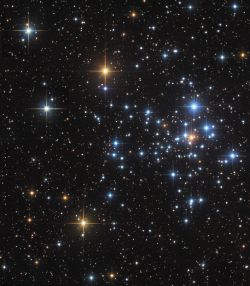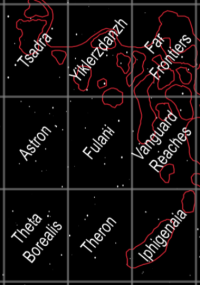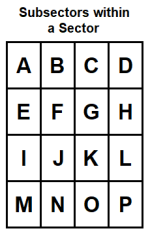Fulani Sector
| Fulani Sector | |||||||||||||||||
|---|---|---|---|---|---|---|---|---|---|---|---|---|---|---|---|---|---|
| |||||||||||||||||
| Subsectors | |||||||||||||||||
|
| |||||||||||||||||
| Sector Data | |||||||||||||||||
| No. of Worlds | 375 | ||||||||||||||||
| Population | 1,421 million | ||||||||||||||||
| Majority Control | Zhodani Consulate - 5% | ||||||||||||||||
| Secondary Control | Other - 95% | ||||||||||||||||
| Gross Sector Product | BCr2,797 | ||||||||||||||||
| Trade Volume | BCr421 | ||||||||||||||||
| Imperial Coordinate | -7 / 0 | ||||||||||||||||
| This sector has a trade map | |||||||||||||||||
| This sector has economic data | |||||||||||||||||
| This sector has sector data | |||||||||||||||||
| This sector has a climate file | |||||||||||||||||
| This sector has sector data | |||||||||||||||||
|
Fulani style="width: 250px; height: 350px; border: solid 1px black; float: right; clear: left" | |||||||||||||||||
Fulani Sector lies rimward of the Zhodani Consulate, towards the spinward edge of explored space.
- It is part of Charted Space.
- The Zhodani know it as Chtedrdia Sector.
- It is a frontier area with little development that has never been fully explored.
Description[edit]
Fulani Sector is a largely unpopulated wilderness lying on the spinward edge of Charted Space.
- The resources of the sector are for the most part untapped.
The first modern interstellar explorers within the region were Terrans of the Rule of Man.
- Evidence of Ancients activity exists within the sector.
The sector was initially surveyed during the Imperial First Survey.
- First Survey primary data regarding the sector was very fragmented.
- The data drew heavily on the records and accounts of previous explorers within the region.
The sector was extensively surveyed during the Imperial Second Survey.
- IISS staff from the Spinward Marches and a few IISS personnel based at Pautho, in Theta Borealis Sector, were able to personally gather limited amounts of data at great personal risk. We salute their valor and honor the fallen.
- Much of the updated data relating to the sector was based on remote long-term observations done over approximately 70 years (from 995 to 1065).
- Most of the output from these observations was automatically collated and generated and may occasionally contain errors.
Astrographic Features & Trade Routes[edit]
The following astrographic and commercial data regarding the sector has been determined:
Summary[edit]
Stellar Distribution[edit]
A basic map showing the distribution and size of stars within Fulani Sector.
- The color corresponds to the visible color of the star, which links to its spectral classification.
- The size as shown indicates both the physical size of the object and its relative brightness.
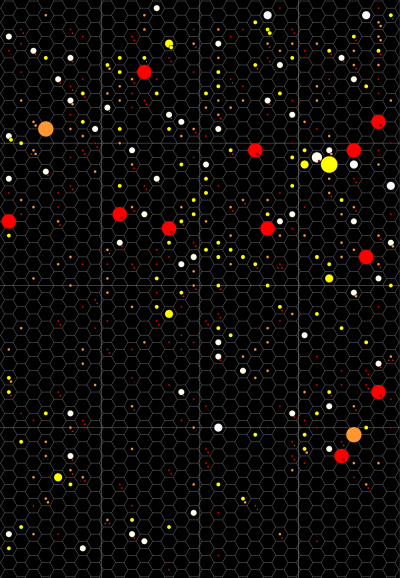
(Chart sourced from Traveller Map)
Note that the stars as depicted are representative. Any star, no matter what its size, is a mere speck within the hex it occupies.
- Ordinary main sequence stars can barely be seen from even a hex away.
- Huge, intensely luminous giant stars can be seen from across the sector and far beyond.
Rift Regions[edit]

A simple map showing rift regions within Fulani Sector, right:
Locally at least, a rift is an astrographic concept based on Jump Drive performance.
The highest tech level commonly encountered out this Far Along (spinward of the Third Imperium) is TL–12, though a few worlds may be more advanced.
- This level of technology allows the routine use of up to Jump-3 drives.
- Areas that cannot be crossed by Jump-3-capable vessels are denoted as rifts.
- Rifts present a significant obstacle to interstellar trade and commerce.
The star Theta Borealis is marked in red.
The sector is adjacent to the Idella Rift and the Helix Rift, vast empty expanses fringed by unpopulated wilderness systems.
Its spinward and rimward subsectors contain The Fissures, a complex of smaller rifts and voids.
- The Heart of Encha, lying to spinward, is supposedly the location of an uncharted space-time anomaly.
Borealis Group[edit]
The spinward-rimward skies of the Fulani Sector are dominated by the Borealis Group, a very large cluster of stars containing an unusually high number of stellar giants.
- It primarily lies within Theta Borealis Sector.
- It is an astrographic feature visible across the whole of Charted Space.
- It is centered on the supergiant star Theta Borealis.
The night skies within the region are spectacular.
Significant Stars
The brightest stars in the group are called the Borealean Stars. They include:
- Theta Borealis: A7 Ia Supergiant, Luminosity: 73,000 sols.
- Sigma Borealis: M9 II Bright Giant, Luminosity: 16,200 sols.
- Tau Borealis: M9 II Bright Giant, Luminosity: 16,200 sols.
They are surrounded by more than sixty other giant and subgiant stars, some almost as bright as the named giants, as well as numerous main-sequence stars and white dwarfs.
- The Borealis Group contains significant amounts of gas and dust that reflects and refracts the light of the stars, giving it an ethereal glow.
Trade Routes[edit]
The Droyne have constructed the Tsehoynu Station, a large facility within an empty hex.
- It lies within hex 0218 of Rosorky Subsector.
- It is equivalent to a Class B Starport.
- It is entirely operated by Droyne personnel.
The Droyne shipyards on Naylyoeatru can manufacture up to Jump-2 range vessels.
- The station facilitates Droyne interaction with the Haddox Association in Astron Sector and with sophont species within the region.
- Its location is widely known and access is freely granted.
A basic map showing the location of the Droyne Tsehoynu Station Deep Space Facility is shown right:
World Listing[edit]
Comprehensive Second Survey data for all worlds lying within Fulani Sector is available.
- The primary source material for all data is Traveller Map.
- Other sources may differ: some elements of the data may be contradictory or incorrect.
- Data is occasionally updated as new information becomes available.
AAB library archives contain expanded data about the following systems:
Note that some Second Survey data, though only 40 years old, may already be out of date.
- Verified updated data is constantly sought.
- Scouting missions gathering reliable, verified data can receive substantial payment.
History & Background (Dossier)[edit]
Fulani Sector is a largely unpopulated and mostly undeveloped frontier. A few worlds within the region have never had an intelligent being visit them.
Native Sophonts: 1105[edit]
The following races (sophont species) are believed to have originated within this sector:
- Non-Human Races
- Chowwar of Chowwara: Heavily built, technologically primitive, aggressive, generally humanoid carnivores with a pragmatic nature and a preference for cold conditions.
- Enchai of Encha: Pelt-covered land slugs that will eat anything organic.
- Esishiai of Viariat: Sweet smelling, downy-furred, dome-headed, trilateral walkers, the last survivors of their destroyed homeworld.
- Huuran of Rosorky: Blind, wormlike, troglodytic, sciapod, pacifist farmers from a hot desert world.
- Koseg of Albaen: Cold-dwelling, semi-humanoid, heavily built, six-armed, white-pelted forest-dwellers with a notably dour nature and a fascination with craftsmanship.
- Nagad of Nagad: Large flying serpentine egg-laying scavengers with two pairs of wings and manipulator tentacles, who live in a strict caste-based society and have an obsessive need to organize.
- Okyar of Evyet: Small, aggressive, broadly humanoid fruit-eating tree dwellers with a dense pelt.
- Rusalkan of Siniokean: Ocean floor-dwelling crablike nomads with a trilateral physiology, a complex caste system, and cut-throat mercantile instincts.
- Sahib of Alsahiba: Slender warlike traditionalist humanoids with a strict hierarchy.
- Varaha of Bhudevi: Egg-shaped hairy trilaterally symmetrical thinkers within vast mindless hives.
- Zarodysh of Zoloto: Irritable, aggressive, forest-dwelling centipede-like carnivore ecologists with an appreciation of music.
The following races (sophont species) are currently only known from this sector but are believed to have other origins:
Demographics: 1105[edit]
Significant populations of the following races (sophont species) reside within this sector:
- Humaniti (Human Races)
- Mixed Solomani/Vilani heritage
- Vlazhdumecta
- Zhodani
- Other Major Races
Toponyms[edit]
This sector has been known by different names to different groups over its existence, including the following:
| Fulani Sector Names | ||
|---|---|---|
| Culture | Toponym | Polity |
| Third Imperium | Fulani | Third Imperium |
| Aslan | Fulani | Aslan Hierate |
| Droyne | Husaaysk | Droyne Oytrip Yatroy |
| Hiver | Fulani | Hive Federation |
| K'kree | Chtedrdia | Two Thousand Worlds |
| Solomani | Fulani | Solomani Confederation |
| Vargr | Chtedrdia | Vargr Extents |
| Vilani | Fulani | Third Imperium |
| Zhodani | Chtedrdia | Zhodani Consulate |
Linguistic Topography[edit]
The following languages are among the most commonly used within this astrographic region:
- Native Languages (the languages spoken by minor races throughout the sector).
- Oynprith
- Riftian Anglic
- Vlazhdumecta
- Zdetl
Historical Eras: 1105[edit]
The earliest interstellar activity in the sector seems to correspond to the Ancients era, between 300,000 and 250,000 years ago.
The Zhodani discovered jump drives in -5415 but they paid little attention to Fulani Sector. A few Zhodani vessels almost certainly travelled among its stars, but they have left almost no tangible traces. Zhodani activity within the sector has significantly increased over the past decades, but is minimal compared to activity in other regions around the Consulate.
As far as is known, the next interstellar visitors to the region were Humans of Terran extraction. These hardy souls had pushed up through the Vilani First Imperium, past the emergent Vargr and across the narrow corridor of stars bridging the Great Rift, and into the vast unexplored territories "Behind the Claw". By the -1900s they had crossed the sector and continued their journey to spinward: settlements and discoveries from the era are known in Mavuzog Sector. For the most part, however, they left few traces within Fulani Sector.
This trickle of Humaniti slowed and then stopped during the Long Night.
In the Year 0 the Third Imperium was founded and over its first few centuries it expanded to spinward. From the 100s onward, small groups of Imperial Humans began to move through the region, spreading their technology and use of jump drives. Few of this new wave of Humans appears to have settled within the sector: like their Terran predecessors they instead continued further to spinward.
From 300 to 420 the Imperial First Survey was conducted. Mostly, this drew together previously scattered survey data and created a basic portrait of the sector. Much of the data related to star positions and types rather than world UWPs and left many blank areas on the map.
After the First Frontier War (589-604), elements of the Zhodani leadership of Iadr Nsobl Province became more interested in territories to rimward. This led to exploration into various rimward sectors, particularly the Vanguard Reaches (immediately trailing of Fulani). In 626, a state called the Driantia Steblenzhtia -- Vanguard Consulate -- was established in the Vanguard Reaches.
In 631, the Zhodani Consulate decided to set up another such state, further to spinward. This planned state (to be known as the Driantia Sitiefladr) would also be a buffer state to prevent expansion of the Talpaku Communality. By the mid 600s, the Consulate had second thoughts about this latter expansion. It was decided that the Izrats Kriezhlas Unity would be an excellent buffer state (at least for the short term), so the Driantia Sitiefladr project was abandoned. The Driantia Steblenzhtia, however, was a success, in time joining with the pre-existing Colonnade Administrative District to form the Consulate's Colonnade Province.
From 995 to 1065 the Imperial Second Survey was conducted. Fulani Sector was included in this grand work and a much more detailed picture of the region was built up, though a great deal still remains unknown. Almost all of the data was gathered via remote observation and from a careful collation of scattered records, though a few hardy IISS personnel undertook long and arduous journeys into the sector to gather first-hand data.
Historical Events Timeline: 1105[edit]
- ca -250,000: The Ancients were active within the sector prior to this point.
- -5415: The Zhodani discover jump drive technology.
- -2431: Terrans discover jump drive technology.
- ca -1900: The first known Human explorers are active in the region (a few Terrans of the Rule of Man). They largely continue to spinward.
- -1776: The Long Night begins.
- Year 0: Far to trailing, across the Great Rift, the Third Imperium is founded.
- 100s-200s: A few pioneering Imperial explorers pass through the sector.
- 300-420: The Imperial First Survey charts the sector.
- 995-1065: The Second Survey charts the sector.
- 1065: The Imperial Second Survey is published.
- 1060s-1100s: The Zhodani increase their presence in the region.
Worlds, Systems & Sectors[edit]
A simple map showing areas of importance within the sector.
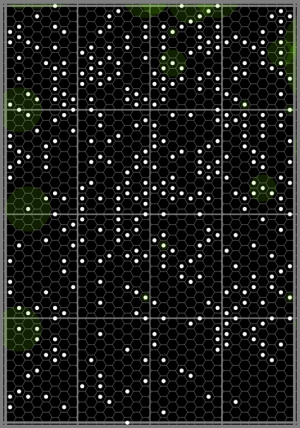
(Chart sourced from Traveller Map)
- Areas of brighter green indicate regions of greater political and economic importance.
Sector Summary[edit]
Note that much of this section relates to pre-Second Survey data and is awaiting an AAB Interal Records update.
The Fulani sector has 375 worlds with an estimated combined population of 3.5 billion, a per capita income of Cr1,969, and a total economy of BCr2,798. These worlds originate an interstellar trade of BCr232 through 19 starports (0 Class A, 6 Class B, 13 Class C, 0 Class D) employing 33,950 people. Driving this interstellar trade are one Agricultural (Ag) world, two Non-Agricultural (Na) worlds, no Pre-Agricultural (Pa) worlds, no Pre-Industrial (Pi) worlds, no Rich (Ri) worlds, and no Industrial (In) worlds. The governments in Fulani maintain six Scout bases and one Naval base. The average technology level is 2 (with most between 0 and 4). The highest technology level is 13 at Vlenzplieshi (Fulani 1903) and Plazzhda (Fulani 1906).
The Fulani sector contains 539 stars; 223 monostellar systems, 146 binary systems, no trinary systems, and six systems with four or more stars. 318 of the 375 systems (84%) have native gas giants. There are 19 Asteroid (As) belts, 26 Desert (De) worlds, no Garden (Ga) worlds, 14 Ice-capped (Ic) worlds, 53 Poor (Po) worlds, 31 Vacuum (Va) worlds, and 38 Water (Wa) or Ocean (Oc) worlds.
Fulani has an estimated population of 3.5 billion distributed across no High population (Hi) worlds, no Moderate population (Ph) worlds, 371 Non-industrial (Ni) worlds, 362 Low population (Lo) worlds, and 117 Barren (Ba) worlds. The highest population worlds are Orsta'e (Fulani 2304) and Peblfliens (Fulani 2301). The population consists of 17 sophont groups.
| 17 identified sophont populations in Fulani | |
|---|---|
|
Polities[edit]
Non-Aligned, Human-dominated[edit]
There are 356 Non-Aligned Human-dominated worlds in Fulani with an estimated population of less than 1 million.
Zhodani Consulate[edit]
The Zhodani Consulate has jurisdiction over 19 worlds in the sector with an estimated combined population of 1 billion, a per capita income of Cr1,969, and a total economy of BCr2,798. These worlds originate an interstellar trade of BCr14 through 19 starports (0 Class A, 6 Class B, 13 Class C, 0 Class D) employing 1,910 people. Driving this interstellar trade are one Agricultural (Ag) world, two Non-Agricultural (Na) worlds, no Pre-Agricultural (Pa) worlds, no Pre-Industrial (Pi) worlds, no Rich (Ri) worlds, and no Industrial (In) worlds. The governments in the Zhodani Consulate maintain six Scout bases and one Naval base within the sector. The average technology level is 8 (with most between 6 and 10). The highest technology level is 13 at Vlenzplieshi (Fulani 1903) and Plazzhda (Fulani 1906).
The Zhodani Consulate has an estimated population of 1 billion within the sector, distributed across no High population (Hi) worlds, no Moderate population (Ph) worlds, 15 Non-industrial (Ni) worlds, six Low population (Lo) worlds, and no Barren (Ba) worlds. The highest population worlds are Orsta'e (Fulani 2304) and Peblfliens (Fulani 2301). The population consists primarily of 2 sophont groups.
Izrats Kriezhlas Unity[edit]
The Izrats Kriezhlas Unity has jurisdiction over 19 worlds in the sector with an estimated combined population of 1.5 billion. These worlds originate an interstellar trade of BCrTBD through 19 starports (0 Class A, 6 Class B, 13 Class C, 0 Class D).
The population consists primarily of 1 sophont group.
Capital: 1105[edit]
No world has been nominated as the capital.
Political Summaries: 1105[edit]
Synopses of the various political allegiances found in this sector:
- CsZh: Zhodani Client State
- IzKU: Izrats Kriezhlas Unity
- NaDr: Non-aligned Droyne-dominated
- NaHu: Non-aligned Human-dominated
- NaSo: Non-aligned Native Sophonts
- NaXX: Non-aligned Unclaimed
- ZhCa: Zhodani Consulate Colonnade Province
Other Political Influences: 1105[edit]
- The "Zhodani Shadow", the perfidious creep of Zhodani influence.
Subsector Listing: 1105[edit]
An overview of the economic and political situation within each subsector:
| Name | Settlement & Economics | Politics | |
|---|---|---|---|
| Subsector A: | Pieshivl Subsector | Primarily wilderness, occasional outposts. | |
| Subsector B: | Aquaria Subsector | Lightly populated frontier, limited trade. | Unity expansion, limited Zhodani influence. |
| Subsector C: | Bilahew Subsector | Settled frontier, regular trade, and commerce. | Unity territory, moderate Zhodani influence. |
| Subsector D | Lythgoe Subsector | Settled frontier, regular trade, and commerce. | Strong Zhodani influence, Zhodani assimilation of worlds. |
| Subsector E: | Rosorky Subsector | Primarily wilderness. | |
| Subsector F: | Zhdierqr Subsector | Primarily wilderness, occasional outposts. | |
| Subsector G: | Tiachtiebria Subsector | Lightly populated frontier, limited trade. | Moderate Zhodani influence, moderate Unity influence. |
| Subsector H: | Vanguard Subsector | Settled frontier, regular trade, and commerce. | Strong Zhodani influence, Zhodani assimilation of worlds. |
| Subsector I: | Encha Subsector | Primarily wilderness. | |
| Subsector J: | Rdrefrn-40 Subsector | Primarily wilderness, occasional outposts. | |
| Subsector K: | Janzya'jopr Subsector | Lightly populated frontier, limited trade. | Strongly independent, limited Zhodani influence. |
| Subsector L: | Zachrisson Subsector | Lightly populated frontier, regular trade, and commerce. | Fiercely independent, very limited Zhodani influence. |
| Subsector M: | Eiebl Subsector | Primarily wilderness. | |
| Subsector N: | Jdinchpipr Subsector | Primarily wilderness, occasional outposts. | Moderate Zhodani influence. |
| Subsector O: | Ozhev Subsector | Lightly populated frontier, limited trade. | Fiercely independent. |
| Subsector P: | Idella Subsector | Lightly populated frontier, limited trade. | Strongly independent, very limited Zhodani influence. |
References[edit]
| This article has metadata. |
| This article is missing content for one or more detailed sections. Additional details are required to complete the article. You can help the Traveller Wiki by expanding it. |
- Classic Traveller Alien Module 4: Zhodani (sector named but no further data)
- J. Andrew Keith, Marc Miller, John Harshman. Aslan (Game Designers Workshop, 1984), . (sector named but no further data)
- Mark Gelinas. Traveller Times (Mark Gelinas, 1987), .
- MegaTraveller Alien - Solomani & Aslan (dot map provided)
- Author & Contributor: Jo Grant of CORE (generated data) / Geir Lanesskog (refinement of data)
- Author & Contributor: Lord (Marquis) and Master Scout Emeritus Adie Alegoric Stewart of the IISS


